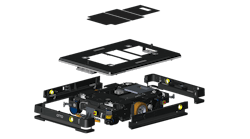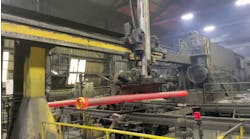Anyone attending Automation Fair, Rockwell Automation’s flagship event being held in Boston this November, will witness an array of diverse technologies in the exhibit hall. From the automation company’s encompassing lineup of partners with non-competitive products to offerings from recent acquisitions such as Plex, Fiix and Kalypso, the breadth of technology can be breathtaking.
Earlier this year, Rockwell Automation made another acquisition with the intent of boosting its Connected Enterprise portfolio. Clearpath Robotics was founded in 2009 and includes Otto Motors, a division of Clearpath launched in 2015 that makes autonomous robotics for industrial applications.
Otto Motors offers autonomous mobile robots (AMRs), designed to create safer and more productive workplaces, transporting parts and materials to assembly lines and between manufacturing cells, as well as fleet-management and navigation software.
Jay Judkowitz, vice president of product, Otto Motors at Clearpath, who has written about how to calculate AMR throughput to maximize return on investment, answered questions about Otto Motors’ AMRs, how they’re distinguished from automated guided vehicles (AGVs) and the technology behind it all.
What autonomous mobile robots does Otto Motors offer?
How does control of an AMR differ from that of an AGV? Can control of a robotic arm be integrated with the navigation software, or is that a separate control system altogether?
Jay Judkowitz, vice president of product, Otto Motors at Clearpath: An AGV requires fixed infrastructure in a facility, such as magnetic tape or barcodes in the floor. An AMR, on the other hand, moves freely around a facility without the need for fixed infrastructure. AGVs can be controlled directly and discretely, while an AMR uses custom software to plan and execute its routes. We can collaborate with custom attachments such that robotic arms can accomplish their tasks and then hand control back to the AMR when finished.
What type of controller does Otto Motors' mobile transport use?
Jay Judkowitz, vice president of product, Otto Motors at Clearpath: We built an entire stack of hardware and software to allow our AMRs to think for themselves.
What kind of charging system does Otto Motors use?
Jay Judkowitz, vice president of product, Otto Motors at Clearpath: We have both manual and automatic chargers, so our customers can send the AMRs to charge, or they can figure it out for themselves through opportunistic charging. In opportunistic charging, the robot gives itself a boost of charge when it isn’t being asked to work. This enables the robots to always be working, increasing facility productivity.
How does it interface with the Fleet Manager software?
Jay Judkowitz, vice president of product, Otto Motors at Clearpath: The Otto Fleet Manager coordinates all the robots together. Think of it like a coach of a basketball team. The players, or AMRs, can independently move around a facility, but Fleet Manager tells which one where to go and when. It coordinates the plays for the day.
What is the operating-system environment used for the controller?
Jay Judkowitz, vice president of product, Otto Motors at Clearpath: Otto robots and Fleet Manager use the Ubuntu operating system.
Does the mobile-transport integrate functional safety into operations?
Jay Judkowitz, vice president of product, Otto Motors at Clearpath: Yes, our robots are completely safe. They use safety-rated light detection and ranging (LiDAR) to perceive their environment, built into their functionality.
Does Otto Motors support the VDA 5050 interface standard? MassRobotics AMR interoperability standard?
Jay Judkowitz, vice president of product, Otto Motors at Clearpath: We support VDA 5050.
How does the fleet-management software interact with real-time data collected by sensors on the AMR?
Jay Judkowitz, vice president of product, Otto Motors at Clearpath: Otto AMRs use safety-rated LiDAR devices to perceive their environment, plan their path and safely navigate across the facility. In collaboration with Fleet Manager, the system can perceive a cart or full pallet in a designated location and automatically send Otto AMRs to interact with it.






